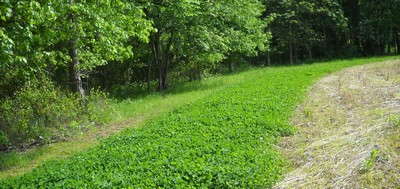The planting of food plots for white-tailed deer is probably the most implemented wildlife management practice in Tennessee. Many landowners believe that food plots provide everything that wildlife need when in fact they comprise the smallest piece of the wildlife habitat puzzle. There is no doubt that deer respond readily to high quality forage, but it’s imperative that hunters and landowners realize what plots can and can not do.
The key elements for whitetail survival are food, water, cover and space. However, given the mild climate and diverse vegetation in the state, food is seldom a limiting factor for deer unless overpopulation occurs. In fact, deer feed on a wide variety of native vegetation, some of which is often considered to be nothing more than weeds by most landowners. Cover, because it is most often lacking, is virtually always much more important than food in determining the abundance of local deer populations. Spring and/or winter food plots can be one part of a management program when they are done properly.

Prior to implementing any habitat or wildlife management practice it is important to consider the advantages and disadvantages of the practice to see if it fits into your overall management plan. One of the advantages of food plots is that they can concentrate animals for viewing and harvest/hunting. Deer and wild turkey can be found on new food plots almost immediately. Many plots in Tennessee are planted to increase antler growth in bucks but does and fawns also benefit from improved nutrition.
Food plots can provide a critical source of late winter food and cover in years of poor plant production (low rainfall) of native food sources or very severe winters. Soil disturbance resulting from food plot establishment is often of greater value to wildlife than grain production due to native plant regrowth. An excellent natural food plot can be created by simply strip disking an area and allowing natural to occur. The “first-responder” weeds that grow on disturbed soil are highly coveted by deer and other wildlife for both forage and seed value.
Food plots must be maintained and cared for just like agricultural crops to attain the maximum benefit. This requires first learning how to establish a food plot and then a lot of work annually on the part of the landowner or manager for a single years’ return. Also, do not use food plots to artificially increase the number of deer the land can support. Food plots generally do not help with what is most needed to wildlife in some parts of Tennessee, primarily cover. There are various native plants that could be seeded that would last indefinitely with proper habitat management.